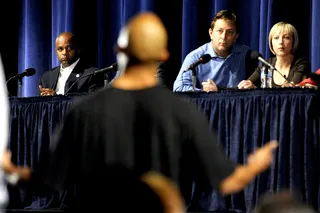A Prescription to End Police Brutality
Leaders offer a path forward to eradicate cop violence.

1 / 14
The Road Ahead - Michael Brown, the unarmed teenager fatally shot by a police officer in Ferguson, Missouri, on Aug. 9, has been laid to rest, but the issues that led to his untimely death live on. A coalition of civil rights leaders have issued recommendations to address the tragic event and prevent the future use of excessive force in Ferguson and communities throughout the nation. – Joyce Jones (@BETpolitichick) (Photo: Joe Raedle/Getty Images)

2 / 14
Killing of Unarmed People of Color - A comprehensive federal review and reporting of all police killings, accompanied by immediate action to address the unjustified use of lethal and excessive force by police officers in jurisdictions throughout this country against unarmed people of color. (Photo: Jeff Roberson/AP Photo)

3 / 14
Excessive Force - A comprehensive federal review and reporting of excessive use of force generally against youth and people of color and the development of national use of force standards. (Photo: Charlie Riedel/AP Photo)

4 / 14
Stop, Frisk, Search - A comprehensive federal review and reporting of racially disproportionate policing, examining rates of stops, frisks, searches and arrests by race, including a federal review of police departments’ data collection practices and capabilities. (Photo: Kevork Djansezian/Getty Images)

5 / 14
Racial Profiling - A comprehensive federal review and reporting of police departments’ racial profiling and racial bias practices, as well as any related policies and trainings. (Photo: Brian Harkin/Getty Images)
ADVERTISEMENT

6 / 14
Racial Bias Training - Required racial bias training and guidance against the use of force for state and local law enforcement that receive grants. (Photo: Ross D. Franklin, File/AP Photo)

7 / 14
Use of Race by Federal Law Enforcement Agencies - A final update and release of the Department of Justice’s June 2003 Guidance Regarding the Use of Race by Federal Law Enforcement Agencies, with substantive reforms including updates that would 1) make the guidance enforceable; 2) apply the guidance to state and local law enforcement who work in partnership with the federal government or receive federal funding; 3) close the loopholes for the border and national security; 4) cover surveillance activities; 5) prohibit profiling based on religion, national origin and sexual orientation. (Photo: Andrew Burton/Getty Images)

8 / 14
Body-Worn Cameras - The required use of police officer body-worn cameras to record every police-civilian encounter in accordance with policy requiring civilian notification and applicable laws, including during SWAT deployments, along with rigorous standards regarding the retention, use, access and disclosure of data captured by such systems. (Photo: Damian Dovarganes, File/AP Photo)

9 / 14
Dash Cameras - The universal use of dash cameras in police vehicles. (Photo: George Steinmetz/Corbis)

10 / 14
Demilitarization of Local Police - Concrete steps to ensure that federal military weapons do not end up in the hands of local law enforcement and, if they do, to prevent the misuse of those weapons in communities of color. (Photo: Scott Olson/Getty Images)
ADVERTISEMENT

11 / 14
Community Training - On-the-ground community training to educate residents of their rights when dealing with law enforcement. (Photo: Scott Olson/Getty Images)

12 / 14
Law Enforcement Commission - The establishment of a law enforcement commission to review policing tactics that would include in its composition leaders/experts from civil rights advocacy groups who represent the most impacted communities. (Photo: Spencer Platt/Getty Images)

13 / 14
Community-Based Policing - The elimination of the “broken windows” policing policy initiated in the 1980s which encourages overly aggressive police encounters for minor offenses and the promotion of community-based policing.(Photo: Allison Joyce/Getty Images)
